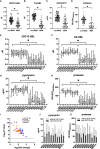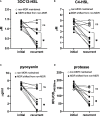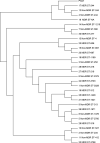Multidrug-resistant Pseudomonas aeruginosa is predisposed to lasR mutation through up-regulated activity of efflux pumps in non-cystic fibrosis bronchiectasis patients
- PMID: 35967851
- PMCID: PMC9363577
- DOI: 10.3389/fcimb.2022.934439
Multidrug-resistant Pseudomonas aeruginosa is predisposed to lasR mutation through up-regulated activity of efflux pumps in non-cystic fibrosis bronchiectasis patients
Abstract
Background: Multidrug-resistant (MDR) Pseudomonas aeruginosa is a frequent opportunistic pathogen that causes significant mortality in patients with non-cystic fibrosis bronchiectasis (NCFB). Although the quorum sensing (QS) system is a potential target for treatment, lasR mutants that present with a QS-deficient phenotype have been frequently reported among clinical P. aeruginosa isolates. We aimed to investigate whether antibiotic resistance would select for lasR mutants during chronic P. aeruginosa lung infection and determine the mechanism underlying the phenomenon.
Methods: We prospectively evaluated episodes of chronic P. aeruginosa lung infections in NCFB patients over a 2-year period at two centers of our institution. QS phenotypic assessments and whole-genome sequencing (WGS) of P. aeruginosa isolates were performed. Evolution experiments were conducted to confirm the emergence of lasR mutants in clinical MDR P. aeruginosa cultures.
Results: We analyzed episodes of P. aeruginosa infection among 97 NCFB patients and found only prior carbapenem exposure independently predictive of the isolation of MDR P. aeruginosa strains. Compared with non-MDR isolates, MDR isolates presented significantly QS-deficient phenotypes, which could not be complemented by the exogenous addition of 3OC12-HSL. The paired isolates showed that their QS-phenotype deficiency occurred after MDR was developed. Whole-genome sequencing analysis revealed that lasR nonsynonymous mutations were significantly more frequent in MDR isolates, and positive correlations of mutation frequencies were observed between genes of lasR and negative-efflux-pump regulators (nalC and mexZ). The addition of the efflux pump inhibitor PAβN could not only promote QS phenotypes of these MDR isolates but also delay the early emergence of lasR mutants in evolution experiments.
Conclusions: Our data indicated that MDR P. aeruginosa was predisposed to lasR mutation through the upregulated activity of efflux pumps. These findings suggest that anti-QS therapy combined with efflux pump inhibitors might be a potential strategy for NCFB patients in the challenge of MDR P. aeruginosa infections.
Keywords: LasR activity; Pseudomonas aeruginosa; efflux pump; multidrug resistance; non-cystic fibrosis bronchiectasis.
Copyright © 2022 Ding, Han, Xue, Yang, Fan, Tang, Zhang, Zhu, Tian, Shao and Zhang.
Conflict of interest statement
CZ and MZhu are employed by Dinfectome Inc., China. The remaining authors declare that the research was conducted in the absence of any commercial or financial relationships that could be construed as a potential conflict of interest.
Figures






Similar articles
-
LasR Variant Cystic Fibrosis Isolates Reveal an Adaptable Quorum-Sensing Hierarchy in Pseudomonas aeruginosa.mBio. 2016 Oct 4;7(5):e01513-16. doi: 10.1128/mBio.01513-16. mBio. 2016. PMID: 27703072 Free PMC article.
-
Mucoidy, quorum sensing, mismatch repair and antibiotic resistance in Pseudomonas aeruginosa from cystic fibrosis chronic airways infections.PLoS One. 2010 Sep 10;5(9):e12669. doi: 10.1371/journal.pone.0012669. PLoS One. 2010. PMID: 20844762 Free PMC article.
-
Genetic adaptation of Pseudomonas aeruginosa during chronic lung infection of patients with cystic fibrosis: strong and weak mutators with heterogeneous genetic backgrounds emerge in mucA and/or lasR mutants.Microbiology (Reading). 2010 Apr;156(Pt 4):1108-1119. doi: 10.1099/mic.0.033993-0. Epub 2009 Dec 17. Microbiology (Reading). 2010. PMID: 20019078
-
Impact of quorum sensing on fitness of Pseudomonas aeruginosa.Int J Med Microbiol. 2006 Apr;296(2-3):93-102. doi: 10.1016/j.ijmm.2006.01.043. Epub 2006 Feb 28. Int J Med Microbiol. 2006. PMID: 16503417 Review.
-
Beyond antibiotics: Emerging antivirulence strategies to combat Pseudomonas aeruginosa in cystic fibrosis.Microb Pathog. 2024 Aug;193:106730. doi: 10.1016/j.micpath.2024.106730. Epub 2024 Jun 6. Microb Pathog. 2024. PMID: 38851361 Review.
Cited by
-
Evolution of Resistant Mutants in Pseudomonas aeruginosa Persister Cells Under Meropenem Treatment.Microorganisms. 2025 Jul 16;13(7):1672. doi: 10.3390/microorganisms13071672. Microorganisms. 2025. PMID: 40732182 Free PMC article.
-
Cultivating antimicrobial resistance: how intensive agriculture ploughs the way for antibiotic resistance.Microbiology (Reading). 2023 Aug;169(8):001384. doi: 10.1099/mic.0.001384. Microbiology (Reading). 2023. PMID: 37606636 Free PMC article. Review.
-
Palmitoleic acid inhibits Pseudomonas aeruginosa quorum sensing activation and protects lungs from infectious injury.Respir Res. 2024 Dec 2;25(1):423. doi: 10.1186/s12931-024-03035-2. Respir Res. 2024. PMID: 39623416 Free PMC article.
-
Fatty acid synthesis promoted by PA1895-1897 operon delays quorum sensing activation in Pseudomonas aeruginosa.AMB Express. 2024 Oct 1;14(1):110. doi: 10.1186/s13568-024-01758-5. AMB Express. 2024. PMID: 39354164 Free PMC article.
-
Novel therapeutic strategies targeting infections caused by P. aeruginosa biofilm.Mol Biol Rep. 2025 Jun 9;52(1):571. doi: 10.1007/s11033-025-10683-0. Mol Biol Rep. 2025. PMID: 40488994 Review.
References
-
- Alnour T. M. S., Ahmed-Abakur E. H. (2017). Multidrug resistant pseudomonas (P) aeruginosa: Medical impact, pathogenicity, resistance mechanisms and epidemiology. JSM. Microbiol. 5 (3), 1046.
Publication types
MeSH terms
Substances
LinkOut - more resources
Full Text Sources
Medical

